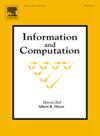Fixed-parameter algorithms for Fair Hitting Set problems
IF 1
4区 计算机科学
Q3 COMPUTER SCIENCE, THEORY & METHODS
引用次数: 0
Abstract
Selection of a group of representatives satisfying certain fairness constraints, is a commonly occurring scenario. Motivated by this, we initiate a systematic algorithmic study of a fair version of Hitting Set. In the classical Hitting Set problem, the input is a universe , a family of subsets of , and a non-negative integer k. The goal is to determine whether there exists a subset of size k that hits (i.e., intersects) every set in . Inspired by several recent works, we formulate a fair version of this problem, as follows. The input additionally contains a family of subsets of , where each subset in can be thought of as the group of elements of the same type. We want to find a set of size k that (i) hits all sets of , and (ii) does not contain too many elements of each type. We call this problem Fair Hitting Set, and chart out its tractability boundary from both classical as well as multivariate perspective. Our results use a multitude of techniques from parameterized complexity including classical to advanced tools, such as, methods of representative sets for matroids, FO model checking, and a generalization of best known kernel for Hitting Set.
公平命中集问题的固定参数算法
选择一组满足一定公平性约束的代表是一种常见的情况。受此激励,我们启动了一个系统的算法研究的公平版本的hit Set。在经典的hit Set问题中,输入是一个宇宙U、一个U的子集族F和一个非负整数k。目标是确定是否存在一个大小为k的子集S≠U,并且与F中的每一个集合相碰撞(即相交)。输入还包含U的子集B族,其中B中的每个子集可以被认为是相同类型的元素组。我们要找到一个大小为k的集合S≥F,且(i)满足F的所有集合,且(ii)每种类型不包含太多的元素。我们将此问题称为公平命中集,并从经典和多元角度绘制出其可处理性边界。我们的结果使用了大量的技术,从参数化的复杂性,包括经典的到先进的工具,如,阵的代表集的方法,FO模型检查,和最著名的核hit Set的推广。
本文章由计算机程序翻译,如有差异,请以英文原文为准。
求助全文
约1分钟内获得全文
求助全文
来源期刊

Information and Computation
工程技术-计算机:理论方法
CiteScore
2.30
自引率
0.00%
发文量
119
审稿时长
140 days
期刊介绍:
Information and Computation welcomes original papers in all areas of theoretical computer science and computational applications of information theory. Survey articles of exceptional quality will also be considered. Particularly welcome are papers contributing new results in active theoretical areas such as
-Biological computation and computational biology-
Computational complexity-
Computer theorem-proving-
Concurrency and distributed process theory-
Cryptographic theory-
Data base theory-
Decision problems in logic-
Design and analysis of algorithms-
Discrete optimization and mathematical programming-
Inductive inference and learning theory-
Logic & constraint programming-
Program verification & model checking-
Probabilistic & Quantum computation-
Semantics of programming languages-
Symbolic computation, lambda calculus, and rewriting systems-
Types and typechecking
 求助内容:
求助内容: 应助结果提醒方式:
应助结果提醒方式:


